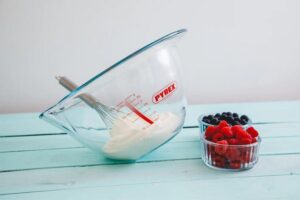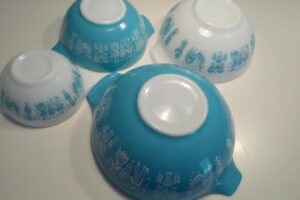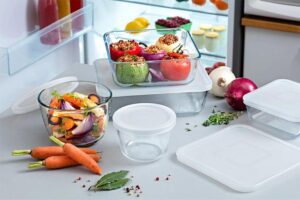In this age of bustling kitchen essentials, Pyrex has carved its place as a timeless companion for chefs. But many are at a crossroads of which type of Pyrex to choose.

They eye the treasure troves of old Pyrex in vintage shops and the gleaming displays of new Pyrex in modern stores. That can be a very frustrating dilemma.
Join us on this culinary journey as we explore the comparison between an old Pyrex and a new Pyrex. We will discuss their distinctive characteristics and help you make an informed choice.
History of Pyrex
Pyrex, a name echoing through kitchen history, is synonymous with sturdy glassware that withstands the test of time.
Born in the early 20th century, Pyrex was initially made with borosilicate glass. At the time, it was celebrated for its resistance to thermal shock.
But over the years, Pyrex has evolved, and with that evolution came changes in material composition and design.
Old Pyrex is fortified with borosilicate and as mentioned was celebrated for its exceptional resistance to temperature changes.
The shift to soda-lime glass in the new Pyrex, while making it more affordable and lightweight has altered its thermal shock resistance.
Old Pyrex and New Pyrex – Comparison
We’ll now compare Old and New Pyrex to help you chefs make an informed decision about which of the two to settle for. Below are the criteria for our comparison in this guide:
Durability and Resilience
Old Pyrex
Old Pyrex stands as a seasoned companion, weathered by years of family feasts and generations of recipes.
Crafted from robust borosilicate glass, this vintage glassware boasts a resilience that’s become legendary in kitchens around the globe.
The thermal shock resistance of old Pyrex makes it a trusty ally for chefs who dance between oven and table. From roasting the perfect turkey to presenting a steaming lasagna, its durability tells a tale of countless meals and memories.
New Pyrex
The new guard, crafted from soda-lime glass, steps onto the scene with a different kind of resilience.
While it may not boast the thermal shock resistance of its predecessor, the new Pyrex introduces chefs to a world of contemporary adaptability.
New Pyrex aligns with the agility demanded by chefs in today’s kitchens. Its resilience shines in the face of daily demands – from microwave reheating to refrigerator storage.
The versatility of modern Pyrex is a nod to the ever-evolving needs of culinary enthusiasts.
Whether it’s the enduring durability of old Pyrex or the adaptable resilience of new Pyrex, both versions continue to etch their stories onto the canvas of culinary experiences.
Even Heat Distribution

Old Pyrex
Old Pyrex, crafted from robust borosilicate glass, takes center stage as the maestro of even heat distribution. The secret lies in the thermal properties of this vintage glassware, which conducts heat uniformly across its surface.
Old Pyrex embodies consistency. When you’re baking a delicate soufflé or a family-favorite casserole, the last thing you need is uneven cooking. Old Pyrex ensures that every bite is an orchestra of flavors, perfectly harmonized.
The ability of Old Pyrex to withstand extreme temperature changes without compromising its even heat distribution makes it a stalwart ally for chefs navigating the delicate dance between oven and table.
New Pyrex
In the era of modern kitchens, the new Pyrex, fashioned from soda-lime glass, steps onto the stage with a different tune. While it may not possess the thermal shock resistance of its predecessor, the new Pyrex introduces chefs to a melody of adaptability.
Many Modern Chefs find solace in the adaptability of the new Pyrex. Whether you’re using it in the microwave or transferring it to the freezer, the even heat distribution is impressive. It adapts to the modern rhythms of my kitchen. This remarkable ability showcases the versatility of this newcomer.
New Pyrex aligns with the agility demanded by chefs in today’s kitchens. Its ability to distribute heat uniformly, albeit with a different glass composition, ensures that every dish gets its fair share of the culinary spotlight.
Versatility in the Kitchen
Versatility is the key that unlocks a chef’s creativity. It allows them to seamlessly transition between cooking techniques and presentation.
Old Pyrex
In the culinary chronicles, old Pyrex emerges as the timeless chameleon. It effortlessly adapts to a myriad of kitchen usage.
Crafted from resilient borosilicate glass, vintage Pyrex is celebrated for its ability to transition seamlessly from the oven to the table.
Old Pyrex is an indispensable tool. The versatility of old Pyrex in preserving tradition while embracing modernity is unmatched.
The classic designs and sturdy build of old Pyrex make it a go-to choice for chefs seeking a versatile companion that complements both baking and presentation.
New Pyrex
In the age of contemporary kitchens, the new Pyrex, hewn from soda-lime glass, steps into the spotlight as a modern marvel of adaptability.
While it may not boast the same thermal properties as its predecessor, the new Pyrex introduces chefs to a world of designs and functionalities tailored to modern needs.
The sleek designs and modern patterns make it a statement piece on the table. From microwave reheating to refrigerator storage, the new Pyrex adapts to the versatility demanded by the kitchen.

New Pyrex aligns with the agility required by chefs in today’s kitchens, offering versatility not just in function but also in aesthetics, seamlessly blending into modern culinary aesthetics.
As the choice drama unfolds, the verdict on versatility remains the decision of each baker or chef. Old Pyrex, with its timeless charm, continues to win hearts with its ability to bridge the gap between tradition and modernity.
Meanwhile, the new Pyrex, a contemporary virtuoso, introduces chefs to a world of sleek designs and functionalities tailored to the demands of the modern kitchen.
Ease of Care
The spotlight is now on the often-overlooked backstage hero—ease of care. For chefs juggling an array of tasks, the ability to maintain kitchen tools with minimal fuss is paramount.
Old Pyrex
Old Pyrex stands as the stalwart survivor, weathered by countless family feasts and generations of recipes.
Crafted from robust borosilicate glass, this vintage glassware not only boasts culinary resilience but also a remarkable ease of care.
Old Pyrex is a testament to durability and ease of care. You can throw the old Pyrex into the dishwasher countless times, and it comes out unscathed. It’s a workhorse that doesn’t demand delicate handling.
The dishwasher-friendly nature of old Pyrex, combined with its resistance to stains and odors, makes it an ideal companion for chefs seeking hassle-free care in the midst of their culinary exploits.
New Pyrex
New Pyrex, fashioned from soda-lime glass, steps onto the stage as a contemporary contender in ease of care. New Pyrex introduces chefs to a world of convenience tailored to the demands of the present.
The lightweight design makes handwashing a breeze, and it dries quickly. In the chaos of a busy kitchen, the convenience of the new Pyrex is a game-changer.
New Pyrex aligns with the on-the-go lifestyle of chefs, offering easy handwashing and quick drying for those who prefer to bypass the dishwasher.
The verdict on ease of care is a harmonious tale. Old Pyrex, is the choice of chefs who value low-maintenance companionship. New Pyrex, caters to the fast-paced rhythm of modern kitchens.
Wrap Up
In this Old Pyrex and New Pyrex comparison, we’ve traveled through the ages of Pyrex and discovered its vintage charm and modern appeal.
As you embark on your Pyrex journey, may the choices you make in your kitchen echo the warmth and joy these glass companions offer. Whether old or new, Pyrex is not just a glass; it is a vessel of stories.
